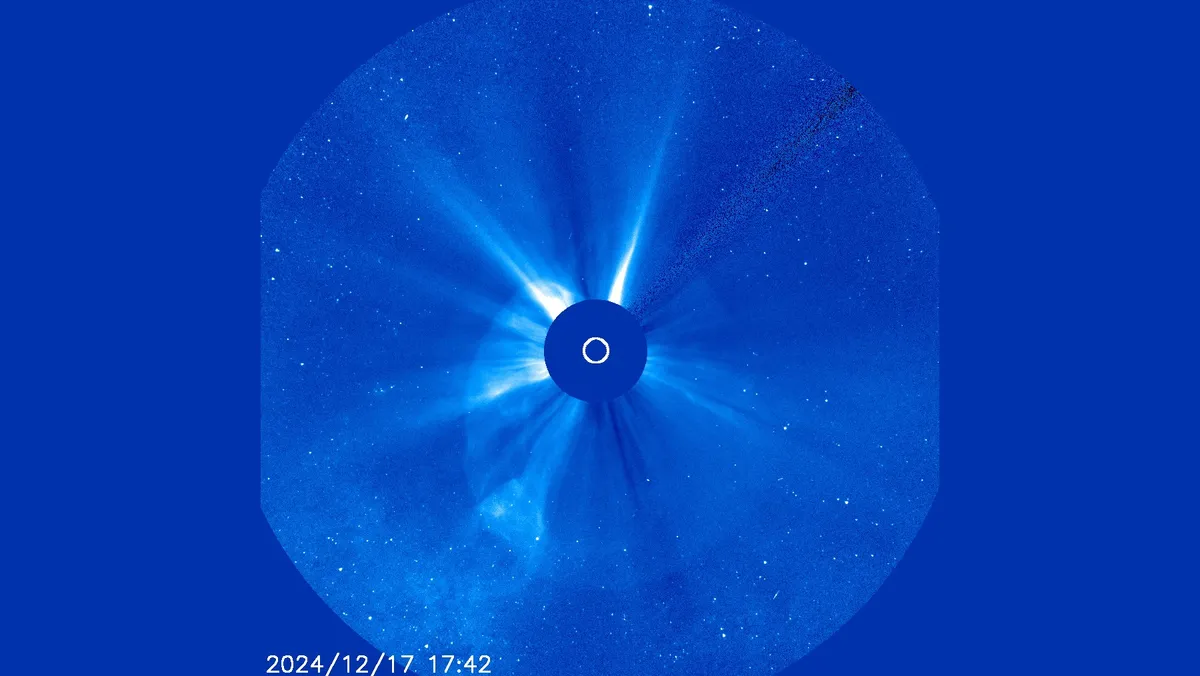
Posted on 12/20/2024 6:29:06 AM PST by Red Badger
This and other recent coronal mass ejections were not directed towards Earth.

The extremely rare coronal mass ejection seen like a bubble stretching around the Sun!
Image Credit: NASA/ESA/SOHO
Solar scientists think there is a very active sunspot on the far side of the Sun. Sunspots are a common feature, especially during Solar Maximum, but we are yet to see this particular one. It will come into view next week, but something must be stirring the solar activity. In the last 10 days, four coronal mass ejections (CMEs) have been seen leaving the other side of the Sun. Among them, one with a speed so exceptional that its classification is simply: extremely rare.
.gif)
The CMEs released on December 17. Image Credit: NASA/ESA/SOHO
These extremely rare coronal mass ejections (ER CMEs) move at more than 3,000 kilometers (1,864 miles) per second. That’s more than 1 percent of the speed of light. They happen less than once every 10 years. This is where the fun starts. The last ER CME was in March 2023. That one too, luckily, was moving away from Earth and did not impact the planet.
The latest one took place on December 17, preceded by two smaller CMEs. The first two were described by solar physicist Dr Ryan French as extremely photogenic – and we can’t disagree with his professional assessment. But it was the later one that broke records.
It was a full halo CME and it left the Sun at a phenomenal 3,161 kilometers (1,964 miles) per second. If it had been directed towards Earth, it would have reached our planet in just 18 hours. Usually, CMEs take a couple of days to reach us.
Dr French pointed out that if this CME had been directed at Earth, it could have caused one of the largest geomagnetic storms in decades. That would not just mean incredible aurorae to lower latitudes as we saw back in May. It would also mean power grid fluctuations, transformers breaking, and satellites experiencing more drag and getting electrically charged. There are serious risks when it comes to these extreme events.
The strongest geomagnetic storm on record is the “Carrington Event”, but it is unlikely that this CME was at its level. A geomagnetic storm as extreme as Carrington would be an incredibly serious natural disaster.
Back in 2008, NASA estimated a similar event could leave up to 130 million people in the US without power, which would lead to “water distribution affected within several hours; perishable foods and medications lost in 12-24 hours; loss of heating/air conditioning, sewage disposal, phone service, fuel re-supply and so on.” Insurance market Lloyd’s estimate that the damage from a Carrington-level event in today’s world would be between $0.6 to 2.6 trillion.
We’re all not gonna die, Ping!......................
My son used to be a data technician on SOHO, the satellite that took this image. His job was to capture images like that.
The SOHO satellite was launched the week he was born for a two year solar observation mission. It was dormant for years when a gyroscope failed but they were able to regain communication and it’s been running ever since, capturing incredible images like this.
What?
There’s nothing like the solar system to bring you down to earth!
Greater than 6.7 million MPH, then.
We’re all not gonna die but pack a bag just in case Ping!.......................
It’s folks like your son that bring us such magnificent knowledge and understanding- the technology today is just amazing.
What would Hunter do?
all this cosmic sex talk is...oh wifey, I need you! I feel the urge for a coronal mass ejection. I’ll need your help.
What a cool job!
If the skies are clear next week I might brave the cold and try to photograph that sunspot, or group of sunspots, whichever it may be. Might be worth the effort…
When it reaches the distance from the sun equal to the earth's orbit, it will have slowed down to 6,560,000 miles per hour because of the sun's gravity.
It was. It was actually a part time college job at NASA. He’s an astronautical engineer. His current job is flying an array of four satellites that fly in formation, often very close formation to study magnetic fields.
He just turned in his notice and will be starting something new in the Space Force realm.
Even at 1% light speed, it takes over 13 hours to travel the distance from the sun to the earth.
How exciting. I’m sure you’re very proud of him!
It had dual overhead cams, dual exhaust...
.... AND A HOLLEY 4BBL DOUBLE PUMPER!..........
Wiiiiide slicks in the back. Nitro tank.
Carroll Shelby’s spirit must be lurking there............
Disclaimer: Opinions posted on Free Republic are those of the individual posters and do not necessarily represent the opinion of Free Republic or its management. All materials posted herein are protected by copyright law and the exemption for fair use of copyrighted works.